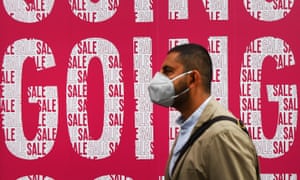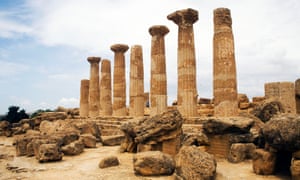UK faces largest GDP decline in 300 years
THE UK economy might not recover from the coronavirus crisis until 2024, the fiscal watchdog has warned.
The Office for Budget Responsibility (OBR) said the ‘UK is on track to record the largest decline in annual gross domestic product (GDP) for 300 years’, warning that the economy could shrink by as much as 14.3 per cent in 2020.
In its latest set of financial forecasts, it said a worst-case scenario would also not see GDP recover to pre-crisis levels until the third quarter of 2024.
Government measures to address the impact of the virus will also result in an ‘unprecedented peacetime rise in borrowing’ this year, to between 13 per cent and 21 per cent of GDP, with the OBR currently predicting borrowing of £322billion.
UK GDP is set to fall by 10.6 per cent in even its most optimistic projection, the OBR said.
However, this scenario also projects that GDP could recover to its pre-virus peak by the first quarter of next year.
In its middling scenario, the OBR suggests GDP could fall by 12.4 per cent, before returning to its pre-virus level by the end of 2022, with ‘elevated’ levels of unemployment and business failures
Earlier on Tuesday, the ONS said that UK GDP grew by 1.8 per cent in May following the easing of the lockdown but remained a quarter below its pre-pandemic levels.
James Smith, research director at the Resolution Foundation, said: ‘The OBR’s forecasts reiterate the scale of the hit to our economy and public finances from the pandemic.’
Weak recovery could make unemployment worse than 1980s levels, warns OBR
Office for Budget Responsibility forecasts UK’s biggest peacetime deficit in 300 years and permanent ‘economic scars’
Richard Partington Economics correspondent
Tue 14 Jul 2020

A pedestrian passes a sale sign outside a store in central London, 10 July 2020. Britain’s high street is continuing to feel the impact of the lockdown caused by the coronavirus, with job losses almost a daily occurrence. Photograph: Andy Rain/EPA
Hopes for a rapid economic rebound from Covid-19 have been dealt a severe blow after official figures revealed a lacklustre return to growth in May with the government put on notice about persistently higher levels of unemployment.
Sounding the alarm over the growth outlook as job losses across the country rapidly mount, the Office for Budget Responsibility (OBR) – the Treasury’s independent forecaster – warned unemployment could rise beyond the levels seen in the 1980s while the country struggles to regain its pre-virus footing.
Faced with a weak recovery and the rapid rollout of government spending to cushion the blow, it said public borrowing was on track to reach £322bn this year, in what would be the UK’s biggest peacetime deficit in 300 years.
The intervention from the OBR comes after official figures showed the UK economy returned to growth in May more slowly than expected, with gross domestic product (GDP) rising by 1.8%.

After the biggest collapse in activity since records began in April, when the economy shrank by a fifth, experts had expected some recovery in May as the government eased restrictions on movement, enabling some construction sites and factories to reopen. However, the bounce back was weaker than growth of 5.5% forecast by City economists.
Issuing a downbeat assessment of the country’s prospects after the disappointing official growth figures, the OBR warned the chance of lasting economic “scarring” was rapidly mounting.
Less than a week after the chancellor, Rishi Sunak, attempted to light the blue touch paper on a rapid economic rebound with £30bn of tax cuts and fresh spending measures, the forecaster said GDP was on-track to fall by 12.4% this year. That would compare with growth of 1.5% in 2019.
Publishing three scenarios in its annual fiscal risks report, it said GDP in the best case would still shrink by 10% before a recovery next year. In the worst-case scenario, GDP would fall by about 14%, marking the deepest recession in three centuries.
In a reflection of the lasting damage from persistently higher levels of unemployment, scrapped business investments and weaker consumer spending, the main scenario included GDP remaining 3% smaller after five years than would have been the case without Covid-19.
If you have been affected or have any information, we'd like to hear from you. You can get in touch by filling in the form below, anonymously if you wish or contact us via WhatsApp by clicking here or adding the contact +44(0)7867825056. Only the Guardian can see your contributions and one of our journalists may contact you to discuss further.
Tell us
Concerns are mounting over the pace of Britain’s economic recovery as the government prepares to wind down its furlough scheme from next month. Labour, business leaders and trade unions have warned that Britain’s road to recovery could be longer and more challenging than hoped, requiring more government support to save jobs than promised by Sunak last week.
Although the OBR said it was not given enough time by the Treasury to include Sunak’s spending measures in its latest analysis, it said it anticipated a sharp rise in job losses as the government winds down its furlough wage subsidy scheme.
At least 10% and as much as a 20% of the 9.4m jobs furloughed on the scheme will be made redundant, it said, as state subsidies are reduced from the start of August and removed entirely by the end of October.
Under every scenario, it said unemployment would more than double from pre-Covid levels, with the jobless rate in Britain hitting a peak of 12% before Christmas under its main forecast. At levels surpassing the hit to jobs caused by the 2008 financial crisis, the unemployment rate last peaked close to 12% in 1984. The current jobless rate is 3.9%.
Anneliese Dodds, the shadow chancellor, said the analysis showed the government needed to listen to calls from Labour, business groups and trade unions for more support to be given to the hardest-hit firms through the furlough scheme.
“Instead of withdrawing support across the piece, he must target it to sectors where it’s needed most. If he doesn’t act, even more people run the risk of being thrown into the misery of unemployment and our economy will continue to suffer,” she said.
Although there are hopes that a stronger recovery could take hold as the government rolls back lockdown restrictions, initial attempts to get more people back to work in May resulted in a weaker bounce back than hoped for.
Manufacturing and construction grew strongly as building sites and factories began to reopen, although service sector firms – including those in retail, hospitality and leisure – continued to struggle due to lockdown restrictions and reduced demand.
Suren Thiru, head of economics at the British Chambers of Commerce, said: “The pickup in output in May is more likely to reflect the partial release of pent-up demand as restrictions began to loosen, rather than evidence of a genuine recovery.Sign up to the daily Business Today email or follow Guardian Business on Twitter at @BusinessDesk
“While UK economic output may grow further in the short term as restrictions ease, this may dissipate as the economic scarring caused by the pandemic starts to bite, particularly as government support winds down.”
Faced with the sharp increase in borrowing to pay for its Covid-19 response and the smaller size of the UK economy in future, the OBR said the government would need to find an additional £64bn a year from tax rises or a return to austerity to put the public finances back on a sustainable trajectory.
Sunak said the growth figures from the Office for National Statistics underlined the scale of the challenge the government faced.
“I know people are worried about the security of their jobs and incomes. That’s why I set out our plan for jobs last week, following the PM’s new deal for Britain, to protect, support and create jobs as we safely reopen our economy,” he said.












